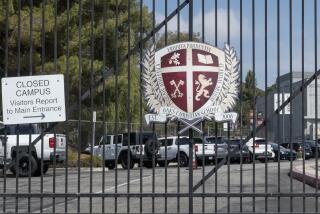‘I Expected Far Better Treatment’
- Share via
Terrence Roberts remembers vividly those September days of 1957 when he and eight classmates repeatedly tried to get past the Arkansas National Guard to enter Little Rock’s all-white Central High School.
Stark images of nine neatly dressed African American teenagers passing mobs of angry white protesters hurling insults dominated the national and world headlines for days. It took three weeks, an order from President Eisenhower and a contingent of Army soldiers to force school officials, the governor of Arkansas and the National Guard to let Roberts and the others begin classes.
It was just the start of a year he now refers to as a long and “necessary march,” a time when the weight of the civil rights movement seemed to rest on the teenagers’ slender shoulders, Roberts told a crowded assembly at Los Alamitos High School last week during Black History Month.
Sharing a school with 1,900 white students, most of whom wanted them to return to their all-black high school, the “Little Rock Nine” daily faced challenges such as trying to distinguish broken glass from water on shower floors, and dodging knives, kicks and punches from their classmates, he recalled.
“I was naive to conclude that it would fade away,” said Roberts, now 58, chairman of the psychology department at Los Angeles’ Antioch College. “I was not prepared by the fierceness of the opposition. I expected far better treatment and got far worse.”
For the 500 mostly white students jamming the campus’ performing arts center, it was almost inconceivable that people their own age could have endured such abuse and hardship. But his greatest lesson, Roberts said, was that there is more to life than the concerns of the individual.
“It was not about self; it was about principle and that goes far beyond the person. It was about justice,” he said.
Roberts was invited to speak by Griffins With a Mission, a campus group formed about seven years ago to promote tolerance and diversity at their school and others within the suburban district known for its good schools and high test scores. When peppered with questions from students and teachers alike, he answered with patience and dignity, trying to convey what those long-ago days were like.
Central High School had been ordered by the federal government to accept African American students under Brown vs. Board of Education, a 1954 U.S. Supreme Court decision that found racial segregation in public schools unconstitutional. Schools around the country had slowly begun to integrate their campuses. In some states, like Arkansas, there were showdowns like those over the Little Rock Nine.
At the neighboring all-black Horace Mann High School, Roberts was a straight-A student who wanted better opportunities. When Mann students were asked if they wanted to attend Central, which had a reputation as a top school, he volunteered. It was a “no-brainer,” he said.
But Roberts, who was a junior in 1957, said it was tough to take the torments his classmates dished out daily.
“It was not so much about the teasing; they were trying to kill me,” he said. But he told the Los Alamitos teenagers he discovered the power of nonviolence. To stand and look your enemy in the eye, he said, can sometimes be a formidable weapon.
Not all could turn the other cheek. A frustrated Minnijean Brown Trickey was expelled that year for dumping a bowl of soup on a classmate’s head. The rest of the group was greeted the next day with cards that said, “One down, eight more to go.”
Only one of their number would graduate from Central High. Ernest Green, who later became an assistant secretary of Housing and Urban Affairs under President Carter, got his diploma. The next year, Gov. Orville Faubus closed all public schools to prevent further integration.
Financially able families sent their children to private schools. The less fortunate, white and black, had their education cut short or had to move elsewhere to attend school.
Roberts and his family moved to Los Angeles, where he graduated from Los Angeles High in 1959. He got bachelor’s and master’s degrees at UCLA, and a doctorate from Southern Illinois University. He and his wife have two adult daughters and live in Pasadena.
Other members of the Little Rock Nine have gone on to become businessmen, social workers, an accountant, a teacher, a journalist and a real estate agent. In a White House ceremony late last year, President Clinton and members of Congress awarded each of them the Congressional Gold Medal, the nation’s highest civilian honor.
During a question-answer session, one of the few African American students said, “I just wanted to thank you for being a part of the Little Rock Nine. It’s because of you that I’m able to go to this school.” Enthusiastic applause followed.
But the mood turned somber when another student asked whether society has progressed much since those turbulent times.
“No,” Roberts answered. “I see that we live in a country that’s founded on the ideology of racism. . . . When 99% of CEOs of companies are white . . . it’s not about merit, it’s about privilege.”
More to Read
Sign up for Essential California
The most important California stories and recommendations in your inbox every morning.
You may occasionally receive promotional content from the Los Angeles Times.













